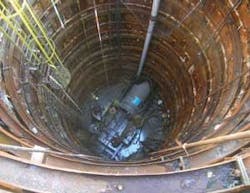FRP Pipe Implemented in Two Cleveland Sewer Projects
By Kimberly Paggioli
Since it was created in 1972, the Northeast Ohio Regional Sewer District (NEORSD) has planned, designed, constructed, operated and maintained over $1.8 billion in facilities to solve regional problems associated with sanitary and combined sewers in the greater Cleveland Metropolitan Area. Like most municipalities, they face the continuing challenge of expanding and maintaining their infrastructures. They selected fiberglass pipe and utilized tunneling for two recent projects.
Triad Engineering and Contracting of Walton Hills, a Cleveland suburb, installed HOBAS centrifugally cast, fiberglass reinforced, polymer mortar (CCFRPM) pipe on two separate projects for NEORSD. The two contracts have an estimated construction cost of approximately $10 million. To finance the projects, NEORSD obtained a low interest construction loan from the Ohio EPA Water Pollution Control Fund.
Named for the streets where it is located, the Bryden-Farnsleigh Intercommunity Relief Sewer (BFRS) is one of 14 sewer projects constructed by NEORSD. Its capacity is necessary to eliminate sewer backups and basement flooding in the area. The BFRS system includes 10,680 feet of 8" to 36" diameter pipe. Of this, about 2,300 feet was constructed by tunneling methods and the remainder by open cut.
Mill Creek is a scenic attraction in Cleveland and the E. 90th Street Relief Sewer project (MCSO-4) is designed to reduce the number of combined sewer overflows to its tributaries. To do this, the project intercepts a portion of the flow at the regulator manhole on E. 88th Street and carries it to the Mill Creek Storage Tunnel on E. 90th Street.
This project consists of approximately 3,150 feet of 36" diameter sewer. Depths are mainly 35 to 70 feet for most of the project but are as shallow as 10 feet at the north end. The underground installation was accomplished by tunneling. Surface work included only access shafts for the launching and receiving pits and a new regulator manhole.
Commenting on the BFRS project, Clifford J. Kassouf, president of Triad, said, “The initial parts of this project were open cut through a tight, older residential street, which then led onto a major roadway.”
Part of this stage involved the installation of a triple sewer, which included the new relief sewer and the replacement of the local storm and sanitary sewer. The final phase was the tunnel installation, which was done with Triad’s Akkerman tunnel and pipe jacking equipment. The tunnel was excavated in silty clay and pipe jacking lengths ranged from 460 to 700 feet.
The original project specifications called for a 36" diameter pipe for the tunneling portions of the projects, but allowed the opportunity to upsize to a maximum diameter of 48 inches. Triad chose the upsize option and used their Akkerman machines, a 48" TBM with 49.5" bore and an SP400 Jacking System.
Two alternate pipe materials were allowed for the tunnel portion: RCP and CCFRPM. Triad chose HOBAS CCFRPM because it fit the tunneling machine. Their confidence in the product confirmed the choice.
The ground conditions on the two installations were varied. “BFRS was in a geologic area that was predominantly stiff silty clay,” said Tom Shively, construction supervisor with NEORSD for the BFRS.
MCSO-4 Construction Supervisor Russ Wahalya noted, “Our geology was quite different from BFRS. This project was designed to be mined in predominantly soft shale, but Triad encountered sandstone strata that dipped into the tunnel zone.”
Despite the mixed geologic conditions, the pipe performed well. All drives were completed without a single failure or joint leak.
The CCFRPM pipe was specified with PVC bushings to be used for bentonite lubrication when necessary. The same PVC bushings could be utilized when grouting the residual annular space with either bentonite or grout.
“On the BFRS project, the annulus was grouted but it wasn’t necessary on the MCSO-4 project. The pipe functioned well and we were pleased with the performance,” said Wahalya.
“In spite of the challenges on BFRS, the project was completed ahead of schedule,” said Kassouf. Testing for infiltration was done after the pipe was installed and none was found in either the pipe wall or at the joints.
“The [BFRS] project went very well. The only problems we had during mining were related to the geology. This didn’t affect the pipe’s ability to perform though and all of the jacking runs were completed successfully,” said Shively.
The job is now substantially complete with only a small amount of surface restoration to be performed. On December 7, 2006, the system became fully functional, accepting flow.
About the Author:
Kimberly Paggioli, P.E., is marketing manager for HOBAS Pipe USA. She has an undergraduate degree in civil engineering and an MBA and has worked in the pipe industry for 14 years. Paggioli is involved in various trade organizations at both the local and national levels.



